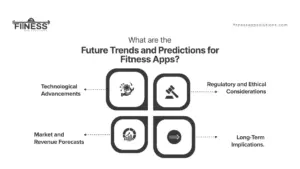In 2025, fitness apps stand at the forefront of a digital health revolution, blending technology with personal wellness to empower millions. As per the fitness app statistics 2025, the global market is projected to hit $10.5 billion, driven by a 20% CAGR, reflecting post-pandemic shifts toward remote and personalized health solutions. This growth isn’t merely financial; it’s about users reclaiming control over their bodies and minds through intuitive tools and technologies.
What are the Key Drivers of the Growth?
The evolution from basic pedometers in the early 2010s to AI-driven platforms today has been rapid. Factors like increased smartphone ownership, wearable tech integration, and a societal focus on mental health have fuelled adoption. In 2025, apps are expected to address holistic wellness, including sleep tracking and stress management, transforming passive users into active participants in their health journeys.
What are the User Demographics and Adoption Rates for Fitness App Usage 2025?
Breakdown by Age, Gender, and Socioeconomic Factors:
Fitness apps have democratized health, but usage varies by demographics. Millennials and Gen Z lead at 60% of users, drawn to gamified experiences and social sharing. Women comprise 55% of the population, often focusing on nutrition and mindfulness, while men prioritize strength training. Socioeconomically, higher-income urban dwellers dominate premium features, but low-income groups are catching up with free basic apps.
Global and Regional Adoption Trends:
Globally, penetration reaches 15% of smartphone users, as per Statista, with North America holding 35% market share (as per Business of Apps), Europe at 25%, and Asia-Pacific at 20%. Emerging markets show rapid growth due to affordable data and localized content. Adoption barriers include digital literacy and cost, but initiatives like subsidized apps are bridging these gaps.
Adoption Barriers and Enablers:
Enablers like AI personalization and wearable syncs boost retention, while barriers such as privacy fears deter some. In 2025, hybrid models combining free and paid tiers are expected to increase accessibility, potentially raising global users to 600 million.
Fitness App Key Statistics Table
To visualize the data, here’s a table summarizing user demographics and adoption rates:
| Category | Statistic/Details |
|---|---|
| Global Users (2025) | Over 500 million (up from 400M in 2023) |
| Age Breakdown | Millennials/Gen Z: 60% |
| Gender Split | Women: 55% |
| Regional Market Share | North America: 35%, Europe: 25%, Asia-Pacific: 20% |
| Penetration Rate | 15% of smartphone users |
Source: Fitbudd, Statista, Business of Apps
What are the Popular Features and App Categories that Drive Engagement?

Core Features Driving Engagement:
AI-powered personalization is a standout, tailoring plans to user data and boosting motivation by 40%. Gamification, with challenges and rewards, turns workouts into fun competitions, while wearable integration provides real-time feedback like heart rate monitoring.
App Categories and Their Roles:
Workout trackers log exercises and progress, nutrition planners handle meal logging, and mental health apps offer mindfulness tools. Hybrid apps merge these, with users averaging 30-45 minutes per session. Social features enable virtual communities, increasing engagement by fostering accountability.
Emerging Trends in Features:
In 2025, 70% of apps will use AI for predictive insights, such as adjusting routines for fatigue. This evolution makes fitness more adaptive, helping users avoid burnout and achieve better results through data-driven decisions.
Usage Patterns and Innovations:
Peak usage occurs in mornings and evenings, with trends toward immersive elements like virtual coaching. Innovations like voice-guided workouts cater to busy lifestyles, ensuring apps remain relevant in a crowded market.
How do Fitness Apps Impact on Health and Lifestyle?
Physical Health Improvements:
Fitness app usage leads to 20-30% better fitness metrics, including endurance and weight management. Apps encourage daily activity, with users hitting 8,000-10,000 steps on average, far surpassing non-users and promoting cardiovascular health.
Mental Health and Well-Being Benefits:
Mental health features yield a 25% well-being boost through guided sessions that reduce anxiety. This holistic approach integrates physical and mental fitness, helping users manage stress in high-pressure environments.
Lifestyle Transformations and Community Building:
Apps drive dietary shifts and habit formation, with 15% higher long-term adherence. Virtual groups create support networks, turning solitary workouts into shared experiences and enhancing motivation.
Broader Societal Effects:
On a macro level, apps contribute to public health by reducing sedentary lifestyles, potentially lowering healthcare costs. Users report greater life satisfaction, proving digital tools can catalyse real-world change.
What are the Common Challenges and Limitations Faced by Fitness Apps?
Privacy and Security Concerns:
With 60% of users worried about data sharing, breaches pose risks. Apps must prioritize encryption and transparent policies to build trust, especially as data volumes grow.
User Retention and Accuracy Issues:
App fatigue affects 40% who abandon within six months, due to notification overload. Accuracy discrepancies with medical devices impact 20% of users, leading to potential misinformation and the need for better validation.
Accessibility and Equity Gaps:
Low-connectivity areas limit access, with only 10% of apps offering offline modes. Costs of $50-100 annually for premium features exclude budget users, highlighting the need for inclusive design.
Mitigating Challenges for Sustainable Growth:
Developers can address these by simplifying interfaces and adding educational content. Regulatory frameworks, like enhanced data protection laws, will be crucial to balance innovation with user safety.
What are the Future Trends and Predictions for Fitness Apps?

Technological Advancements:
AI and machine learning will enhance personalization, potentially increasing retention by 35%. VR/AR could attract 20% more users with immersive workouts, while blockchain enables secure reward systems.
Market and Revenue Forecasts:
Revenue may reach $15 billion by 202, driven by subscriptions. Holistic wellness, incorporating environmental factors, will expand app scopes beyond fitness.
Regulatory and Ethical Considerations:
Stricter data ethics will shape development, ensuring apps promote equitable health. Predictions point to a user-centric future where apps adapt to individual needs, democratizing wellness globally.
Long-Term Implications:
By 2030, apps could integrate with healthcare systems, offering predictive care. This evolution will empower users further, making fitness a lifelong, tech-enhanced journey.
Conclusion
Fitness apps in 2025 are transforming lives, with 500 million users driving a $10.5 billion market. From demographic shifts to AI innovations, they have made health accessible and engaging. Users should choose secure apps aligned with goals; developers focus on inclusivity; policymakers enforce ethical standards. Together, we can harness this potential for a healthier world.
Frequently Asked Questions (FAQs)
What is the projected market size for fitness apps usage in 2025?
The global fitness app market is expected to reach $10.5 billion by 2025, growing at about 20% each year.
Who uses fitness apps the most in 2025?
Over 500 million people worldwide are projected to use them, with millennials and Gen-Z making up 60% of users. Women account for 55%, and adoption is highest in cities and among those with higher incomes.
What are the top features in fitness apps?
Popular features include AI personalization, gamification for fun challenges, and integration with wearables for real-time feedback. Apps cover workouts, nutrition, and mental health, with users spending 30-45 minutes per session.
How do fitness apps change health and habits?
They can improve fitness by 20-30%, help users walk 8,000-10,000 steps daily, boost well-being by 25%, and increase long-term habit sticking by 15% through community features.
What problems do people face with fitness apps?
Issues include privacy worries, app boredom leading to quitting within six months, and inaccurate data. Costs and limited access in some areas are also challenges.
What trends are coming for fitness apps?
Expect more AI for better plans, VR/AR for immersive workouts, and secure rewards. Revenue could reach $15 billion by 2027, with a focus on overall wellness.
How can I pick the best fitness app?
Think about your goals, like losing weight or relaxing. Look for apps with privacy protection, personalization, and free trials. Check reviews and choose ones that fit your budget.
Are fitness apps safe and private?
Security varies, but many have encryption and clear policies. To stay safe, review app permissions and pick ones that protect your data. Always be cautious with sharing personal health info.



